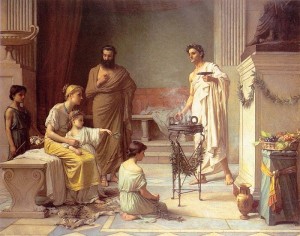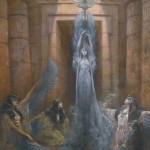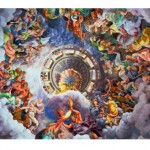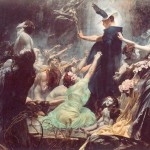Priesthood in the ancient world was a call to service and a coveted honor. The Priestfolk were responsible for maintaining the rhythm of society through worship and festival, nurturing the culture’s connection with the Gods. Pagan Priesthood is far from there, but we can rebuild…
The first duty of the Priest-folk is to bless, to bestow the benefits of the Deity they serve upon the people, places, goods and occasions they are present at or called to. This is a natural outgrown of their primary work which is to serve the Deity who has consecrated them to the task.
This is different than ministry, which is about serving the people, the ‘congregation’ who has called the minister to serve it. In many ways ministry is far harder, in that it requires training to do it well, while serving a Deity ‘only’ requires the touch of the Deity. While these notions are entwined in practice, it is useful to disentangle them for discussion. Today our subject is priesthood, next time it will be ministry.
The reason why I’ve previously written on sacrifice and idolatry is that these are occasions at which priesthood is enacted. While anyone can perform a sacrifice, the priesthood of a certain Deity will have inherited a body of knowledge about how to worship the Deity and acquired deep experience in this through long practice. They know what the Deity likes and how to call Her.
Once an Icon is consecrated and animated, it requires regular service to maintain its connection to the Deity. This is the other aspect of priesthood: the regular worship that is the cult of the Deity has to be performed by those with dedication to the task. Priesthood (often) is constituted by those who take on the commitment to perform the rites at their appointed times. This service is the ‘engine’ of the Priesthood. Connection with the Deity is cultivated in worship, and blessings are, for lack of better words, accumulated and distributed. There are other ways of doing priesthood, but these two are the archetype on which they are all based.
Priesthood is in once sense common and in another quite rare in the Pagan community. In Wicca, every initiate is also considered a priestess or priest, which means we have a lot of them. However, the more restricted sense—that where a person becomes dedicated to a Deity, possibly even makes actual contact with Them, then enters into Their service to maintain Their cult and bestow Their blessings—is more rarified, but growing. The Pagan community is fortunate to be slowly building a body of priest-folk who have taken on these duties.
I am not in the position nor motivated to determine the veracity of those claiming this kind of Divine relationship, but over the last number of years more and more of them are appearing on-line. Since priesthood is hardly restricted to on-line fora, we can safely assume that there are even more priest-folk out there who don’t announce their work on the net. This growth is one of the most crucial developments in the Pagan community today. The establishment and maintenance of Divine cultus is one of the most, if not the most, important tasks for the Pagan community to survive and thrive.
Like in ancient times, contemporary Pagan religious activity is structured around worship (as interpreted in the broad sense). The Gods Themselves constitute the structure, the very scaffold around which our religion and culture are formed. The Gods are the bones of the body Pagan.
This is true for us whether we are hard polytheists, humanists, naturists, or operating from a non-dual frame. In each case there are the Divinities, and irrespective of Their being interpreted as completely separate, aspects of our psyches, human generated stories, manifestations of, simply Nature herself, or in any other theological frame, They abide. They, however framed, are what we gather around to remember, to honor, to affirm their value, or in other words, to worship. Regardless of our understanding of what it means, when we gather in worship we all come together as a community. This is the place where we all meet.
In essence, Priesthood is about setting the table, both for the Gods and the worshipers. We lay out offerings of food and drink, or symbol and word, or dance and action, or art, and call our Honored Guests to come. We gather at the altar—which today may be a card table in a field, or the kitchen table, or a dedicated stone—and the Gods come into our midst. The role of the Priesthood is to bring us all together, to set the table at which all, human and Divine, have a seat. What we think of the Great Ones that we sup with is not so important as being with Them together.
Afterwards, we can have a rousing debate over the theological interpretation of what we all just did. This is the proper way to do religious warfare: in good company over delicious food and drink. We may not agree with each other, but we will have grown closer and perhaps learned a thing or two before going home. (You can see a nice form of this in Rudyard Kipling’s “The Mother-Lodge”.)
In order to cultivate this vital aspect of our religious and communal life, the Priesthoods must also be developed. An ancient (and still used!) method for doing this begins with the Priesthoods of various Deities forming associations, “priestly colleges” as they were called in Rome. The degrees of formality will vary from college to college, dependent on the character of its presiding Deity, and that of the colleagues. With the net today it should be relatively simple to do this. At no time like the present has it been so easy to find folks of like interest.
The priestly colleges can provide mutual support and learning, training for those who aspire to the priesthood, as well as a point of contact for those trying to reach the Deity.
Since I work with, or more properly, for Hermes, I began a project to reestablish His priesthood and cult. At PantheaCon 2012, we consecrated and animated a 6x1x1 foot wooden Herm, which was then rendered due worship in open temple by the gathered community. Priestfolk of other Gods also came to pay their respects. Since then the Herm has been installed in a local store [The Sacred Well, Oakland CA] owned by one of the lead participants in the rite. It, or more properly He now receives monthly worship at the Dark of the Moon in the store, along with His consort Hekate. We’ve had a nice crowd every month since March, and some are considering entering His service. The rite we are doing is a variation on a Dark Moon offering cycle that I and my late wife Tara have been maintaining without fail since January 1992.
I am pleased to say that other priest-folk connected with Hermes have been in touch with me and I hope more do. Perhaps we will be able to form a college. Other Priestfolk have told me about embracing this program. I hope you will too.
With a solid Priesthood, we build deep connections to the Gods for our community and our world that will endure through generations. But caring for those generations spiritually is a different task. It is called ministry and to that we will turn next month.













